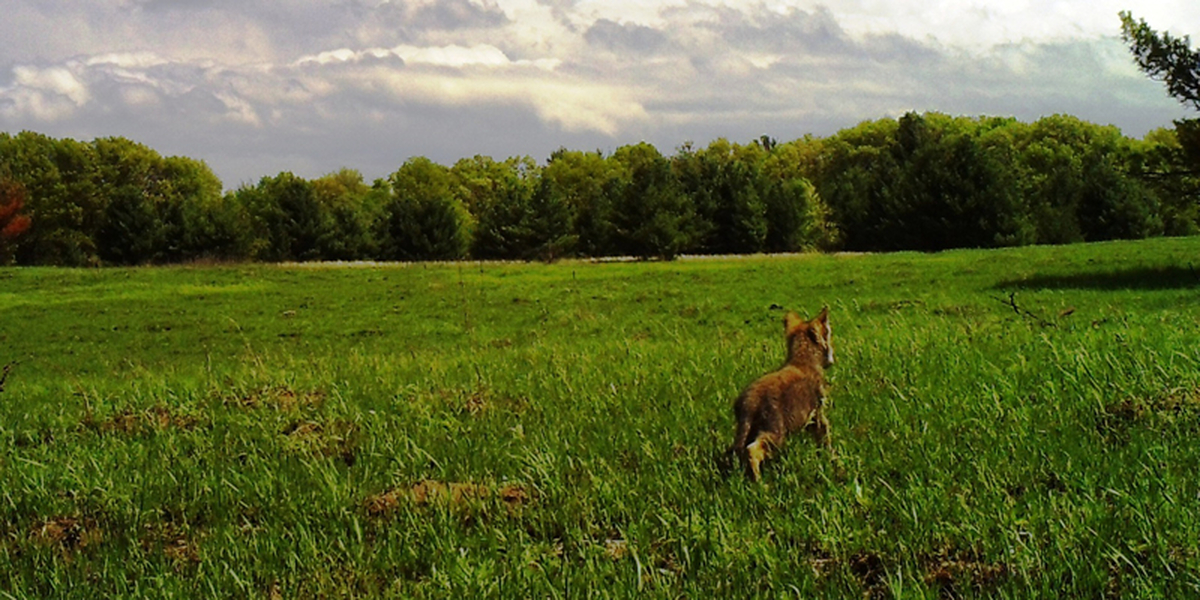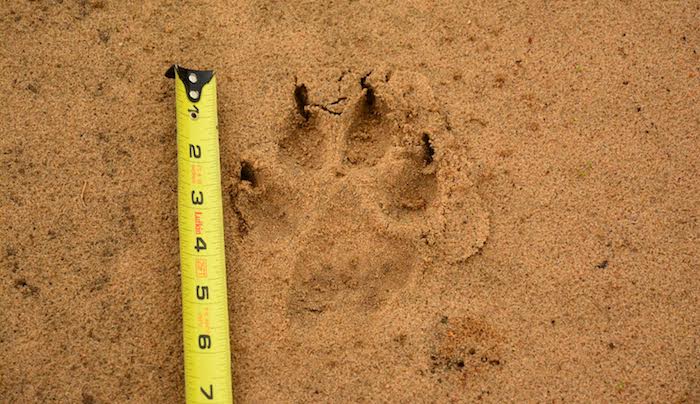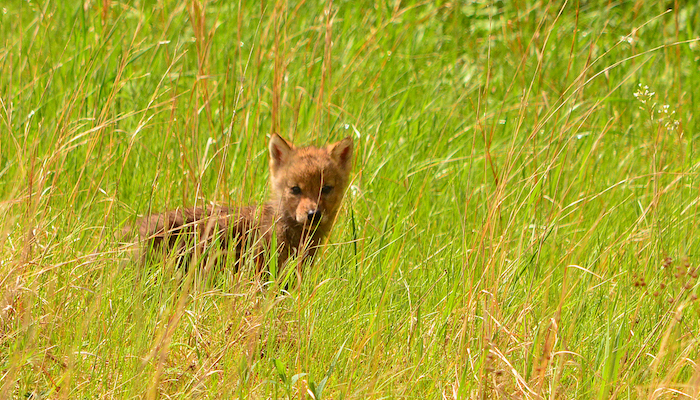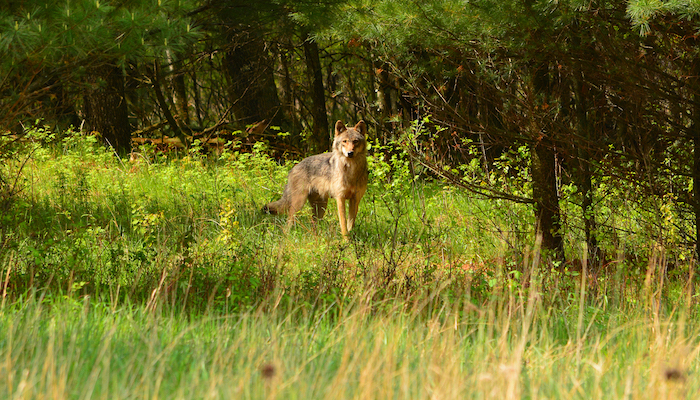
It all started a few years ago when Jim Krueger noticed some large, dog-like tracks on a walk with his wife at Cedar Creek Ecosystem Science Reserve. Krueger serves as buildings and grounds supervisor at the field station in East Bethel, which has an international reputation for ecological research. He’d heard from a neighboring property owner who thought he’d spotted a wolf on adjacent land, put two and two together and decided to investigate.
A scientist by training and an avid naturalist by disposition, Krueger is a keen observer of the land with a special interest in trees and an obvious enthusiasm for the diversity of life present at Cedar Creek. He regularly traverses the property and has photographed more than 55 species of mammals and birds including bobcats, red and gray foxes, cranes, swans and many other birds. On a spring day in 2015, he added wolves to that list.
“I walked up to a den in a clearing and three pups popped their heads up,” says Krueger. He went to work documenting their presence at the station. “I ran into them a half dozen times that year. I even witnessed a group of them chasing a deer.”
Spotting wolves so close to the Twin Cities isn’t unheard of. Lone wolves can travel for thousands of miles. But it’s the first time in a century that a den with a litter of wolf pups has been found so far south, which means the wolves were likely staying in the area for a while. For the last decade or so, breeding wolves have stayed north and east of Pine City up to Baudette according to leading wolf expert Dave Mech. Cedar Creek is the closest to the Twin Cities a den has been found in living memory. Mech, lion expert Craig Packer, and Cedar Creek researchers Forest Isbell and Caitlin Potter, launched a study this fall with funding from the Minnesota Environment and Natural Resources Trust Fund.
The hunt Krueger described has potential implications far beyond the fate of the deer, as it turns out. In fact, it’s one of the reasons the scientists are so interested in studying the wolves. Wolves and other predators can have a major effect on prey behavior, which, in turn, can reshape the environment. This effect is described as creating a “landscape of fear.” For example, the return of wolves to Yellowstone National Park in the mid-1990s turned out to be a boon for scavengers, beavers and other animals, and changed the land itself as elk numbers dropped by 50-75 percent, and elk vacated more open areas seeking to better protect themselves against wolf predation, allowing plants to thrive in places they had not before. The research team hopes to track the Cedar Creek wolves’ movements to determine whether they reduce deer numbers and create a “landscape of fear” by driving changes in prey behavior.
From the Serengeti to the oak savanna
Craig Packer studies a decidedly different kind of predator — the African lion. Packer brings vast experience with large carnivores. He also knows a lot about collecting and analyzing data using camera traps, which he’s done on an unprecedented scale through his ambitious Snapshot Serengeti project. The project has yielded more than a million photos of Serengeti wildlife to date. Thousands of “citizen scientists” around the world then identified the animals and their behaviors.
“Snapshot Serengeti relies on statistical analysis of a large-scale camera grid which has revealed how various different mammalian species in the Serengeti interact with each other and how prey balance their risks of predation with food intake rates across various time scales,” says Packer. “The Cedar Creek grid will take all this to the next level, as any changes in the distribution of deer in response to the influx of wolves into the reserve will be likely to affect the abundance of their preferred food plants — and Cedar Creek has phenomenally good data on plant growth and species composition.”
Packer is interested in the contrast between wolves and lions. He points out that while lions are ambush predators wolves make less effort to conceal themselves, which means deer and elk don't need to worry as much about areas with taller brush. “The landscape of fear is quite different for these two species — with different impacts on the vegetation,” says Packer. “Whereas we would predict that restoring lions to an ecosystem would cause brushy areas to get brushier, the return of wolves to our part of Minnesota might not have a similar impact.”
Tracking an elusive subject
This fall and winter, Isbell and Potter will set up more than 100 cameras at spots around the station to document the movements of whatever wolves may still be in the area. The resulting images will also be used to create Snapshot Cedar Creek, a new online citizen science project designed to engage community members and local students in learning about Minnesota wildlife. “I've already had a number of educators express interest in using Snapshot Cedar Creek as part of their teaching, and will be developing lessons and activities for our local K-12 classrooms,” says Potter, Cedar Creek’s education and outreach coordinator.
While most of the original litter of wolves has either moved on or been eliminated, the researchers believe at least one wolf uses the area. As winter snows descend on Cedar Creek, Mech will get to work looking for tracks. When he first heard about the presence of a litter of wolves at the station he began driving the roads around the station in search of the telltale signs of wolf crossings. “Seeing a wolf track at Cedar Creek is really something,” he says.
The fact that the den turned up at Cedar Creek is an auspicious accident. “Cedar Creek is an ideal site to study the ecological impacts of wolf recolonization because of its decades of comprehensive ecological research,” says Isbell, who is leading the study. “We have data from thousands of plots in dozens of multi-decade studies across the property. It’s a really unique opportunity to understand what the recolonization by wolves means ecologically and socially.” The proposed research will combine existing long-term data with new data on the local abundances and spatial distributions of animals, plants, and soil nutrients. –Stephanie Xenos


